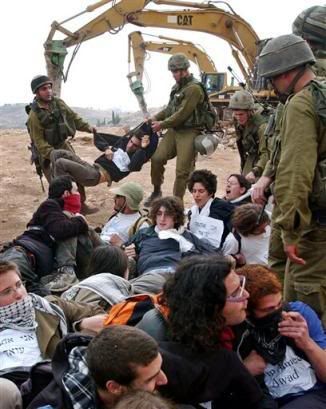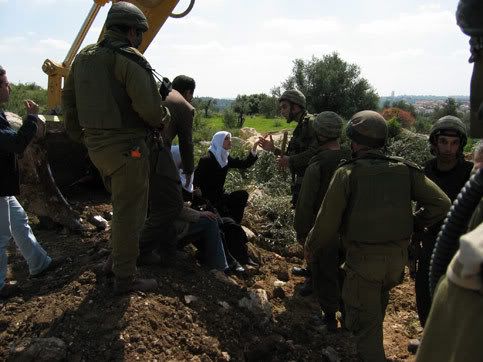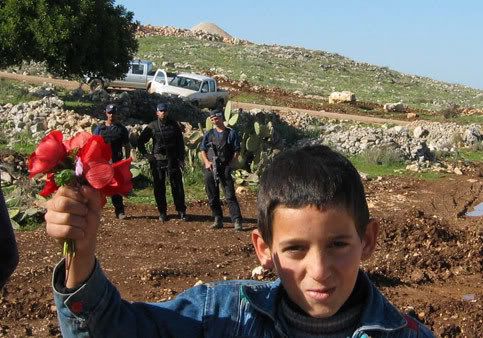Ida Audeh, writing in the Electronic Intifada on 13 June 2007, entitled this article about the village of Butrus’ protest to stop Israel’s Wall from stealing more of their land, A Village Mobilized: Lessons from Budrus.
Budrus is a Palestinian village located about 10 miles northwest of Ramallah close to the Green Line, the border of Israel per international law. Since the Wall is supposed to be there only for Israel’s security, you might immediately wonder why it is coursing through this village. Well, the apparent reality is that the Wall is only “supposed” to be about security. The truth may be somewhat different: an excuse for Israel to continue its land grab or colonialism.
When Budrus was featured in a Nation article in 2004, it was reported that the Israeli human rights group B’Tselem had estimated that the completed barrier would create eighty-one enclaves like Budrus and would expropriate almost 1 million dunams (one dunam= one quarter acre) east of the Green Line, affecting a total of 875,600 Palestinians, or 38 percent of the population in the West Bank.
At that time, the villagers of Budrus along with international activists (shown above) engaged in a daily struggle using their bodies to prevent bulldozers from uprooting villager’s trees and building a 40 meter wide barrier that would take away most of the village land, the only source of living for most of them. Many of the protesters were wounded by the border police and many were arrested.
In fact, even when IDF soldiers confiscate lands adjacent to Israel’s many inland West Bank settlements (Israeli villages, towns, and cities), security is the number one reason given by the military government, even though the land taken may be many miles from the border (or green line) or the Wall. It is called colonization and it is pursued under the cover of a military occupation, whose alleged purpose is to stop “terrorists” from entering Israel. At least that is the line, the concocted story. However, when one considers the 40 year length of Israel’s military occupation, it sounds empty.
It is now 2007 and Budrus is back in the headlines and the story has not changed. Israel wants to confiscate more land.
The article by Ida Audeh is too long to quote in its entirety so that only a portion is posted here. The link below leads to the full account. It is the story of a village that rose up against the Wall with nonviolent resistance. We Americans didn’t invent it. Gandhi did. But we did use it successfully against Jim Crow segregation following the lead of ML King. Now the people of Budrus are using it with marginal success against the Israeli nemesis.
This year marks the 59th anniversary of the dismemberment of Palestine, otherwise known as the establishment of the state of Israel, and the 40th anniversary of Israel’s occupation of the West Bank (including East Jerusalem), the Gaza Strip, and the Golan Heights. Israel and the western world have imposed sanctions on the Palestinians in the occupied territories, the majority of whom now live below the poverty level; and Israel in collaboration with willing Palestinian lackeys continues its savage assault ostensibly on members of Hamas but in reality on all Palestinians who reject the shabby future assigned to them in the Oslo agreement.
The people of Budrus, a village (population 1,300) about 12 kilometers northwest of Ramallah and no more than 3 kilometers from the green line, teach us that Palestinian fate is not carved in stone; the outcome to the Israel-Palestine struggle is not a foregone conclusion. After the 1948 war, Israel confiscated about 80 percent of the land area of Budrus, leaving less than 5,000 dunums, and later established a military training base. Despite the provocation of the base on village lands, not a single shot was ever fired by the villagers, and not a single suicide bomber ever emerged from the village. Then in 2004 Israeli bulldozers arrived to start work on a wall that, when completed, is expected to extend for about 650 kilometers; it had begun in the Jenin area in the northern West Bank in 2003, jutting well into the West Bank and encircling Qalqilya as it snaked along a southwesterly course. And Budrus brought the bulldozers to a standstill.
The story of Budrus is noteworthy because it reminds us that unarmed people are not powerless. Confronted with an Israeli plan to confiscate 1,000 dunums of village lands to erect a wall that would ultimately enclose area villages in a canton, Budrus residents put their bodies in front of the bulldozers that came to raze their farmlands. Unarmed, and abandoned to their fate by the increasingly useless and indifferent Palestinian Authority, the villagers quickly realized that the wall would stifle the area and make their lives unsustainable. They resisted the Israeli juggernaut with their bodies and temporarily stopped it in its tracks. The villagers paid a high price — the Israeli occupation forces conducted mass arrests and inflicted numerous injuries with live ammunition — and despite a legal victory in an Israeli court, ultimately they could not prevent the 3,500-meter wall from being built. But they did manage to change its course, and in so doing safeguarded some of their own and other village lands. This is an achievement that has eluded local and international activists in Bil’in, who have been holding well-attended and well-publicized (2.4 million hits on Google for “Bil’in” versus 51,600 for “Budrus”) demonstrations at the wall every Friday for at least two years now.
Ida Audeh interviewed Abd al-Nasser Marrar, head of the Peace and Love Society and one of the coordinators of the popular resistance committee formed to confront the wall, twice. His responses are instructive. I will quote the questions asked, and some responses, but the reader who is interested will have to consult the full article for the other replies.
The antiwall campaign in Budrus managed to mobilize almost everyone in the village. How would you describe your strategy, and how did it differ from antiwall activities in other areas?
So you consider your resistance to be successful, even though you weren’t able to stop the wall from being built?
How do you get people not to resign themselves to the fact of the wall, since it is in place, a done deal?
How has the wall affected the people of Budrus?
In any house you go to in Budrus, you will find at least one person who has been injured, one imprisoned. And if you want to compare Budrus to other Palestinian villages, you will find higher percentages in Budrus than elsewhere in Palestine. In 2007, 75 people were arrested in one day [and were given sentences or detention orders] for periods of time ranging from 6 months to 10 years — 75 from a village with a population of 1,300 … arrested in a single day. Thirty were arrested in activities related to the wall, most of them children under age 18. About 30 have been injured with live ammunition. Probably about 1,000 injuries with rubber bullets and tear gas. So every person in Budrus has been injured by the occupation. Maybe that’s part of the reason that residents have so much solidarity with one another.
The wall is adjacent to the elementary school. How is it affecting the students?
In school, the kids are afraid and worried. The guards at the wall use tear gas even at a distance. If a kid yells in the direction of the wall, the response is immediate. They try to create an unnatural psychological state. This has been constant, ever since they began the wall here. The policy of the occupation forces hasn’t changed.
The children’s school is no longer a school. The window panes are broken, the classrooms are decrepit. The wall harms the kids’ psyches, it hurts our agriculture, it is bad in every way.
How do you think actions in Budrus affected other areas? You say that the wall moved to Deir Qaddis after Budrus. Was there any coordination between people in these towns?
Yes, there was coordination. In the Ramallah area, Budrus was the first town affected by the wall, and it changed things 180 degrees. A popular committee was formed in Budrus, and then a more regional committee was also formed, and it adopted the Budrus approach. The entire area participated with Budrus and everyone learned from that experience. I have already mentioned that the change in the wall’s path brought about by resistance in Budrus saved some of the land of Ni’lin and al-Midya. Deir Qaddis followed exactly the Budrus model. The only difference is that Deir Qaddis has an Israeli settlement on village lands. So it is impossible to place the wall behind the settlement. Now there are two lawsuits related to the wall. One was filed by the settlement, and the other by the people of Deir Qaddis. The settlers are claiming that the wall is too close to its lands; they want it moved. And the villagers want the wall off village lands. Thus far, work on the wall has come to a stop.
How do you view the Palestinian Authority’s role in this?
The PA has lapsed in its responsibilities toward all the villages west of Ramallah generally and in fact, in the entire West Bank. Its failure has been abnormal and unnatural. Right now, whatever efforts the PA makes are focused on Bi’lin. I don’t see the PA’s media outlets mentioning anything other than Bi’lin. There have been some very difficult humanitarian cases, worse than Bi’lin, that are not mentioned in the media. With all due respect to Bi’lin and the example they set, it is not right to marginalize all other areas and limit the wall to a single focus area.
(snip)
I was arrested with a member of the Swedish parliament. The next day, a parliamentary representative was here and so was the Swedish consul. We had many foreign embassies and ambassadors visiting us here. The Swede who was arrested with me is now forbidden to come here for the next 14 years.
Has the wall affected mobility between villages? Are people leaving this area as a result?
Our mobility has been affected by the settlements, not so much the wall; this is part of the plan for the eastern part of the area. The whole area is going to be in a canton. This is an Israeli plan that has not yet been implemented. It will connect Rantis, pass through Shuqba, Ni’lin, and Kiryat Shevar settlement. That will mean that Shuqba, Shibteen, Budrus, and Ni’lin, and al-Midya will be within a canton. There will be a tunnel from Ni’lin to Deir Qaddis. We don’t know when they will start this, but they are ready to begin. There has been some discussion about forming a committee to oppose this plan. We are working on this.
The situation in Ramallah seems abnormally normal to me, because the city is isolated from what is happening elsewhere.
Of course it is abnormal. When villages are cut off from the city, what becomes of it? What creates life in the cities other than the surrounding villages and towns? Cities are nourished by the life in the surrounding villages. The economy and jobs in cities are spurred by the villages. The movement of people from the villages to the cities is what creates life in the cities. When the villages are cut off from Ramallah, what happens to it? It diminishes.
How do you keep your spirits up? What keeps you going?
Our affection for and solidarity with one another.
(Snip)
Ida Audeh is a Palestinian from the West Bank who works as a technical editor in Boulder, CO. She is the author of the five-part series, “Living in the Shadow of the Wall,” published by Electronic Intifada on 16 November 2003; “Picking Olives and Removing Roadblocks as Acts of Resistance: An Interview with Ghassan Andoni,” Counterpunch, 28 October 2002; and “Narratives of Siege: Eyewitness Testimonies from Jenin, Bethlehem, and Nablus,” Journal of Palestine Studies, no. 124 (Summer 2002).
Material was reprinted in accordance with Electronic Intifada’s, ISM, and Stop Caterpillar copyright policies.







